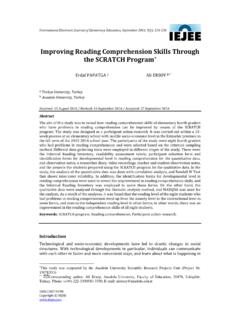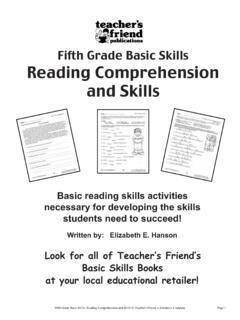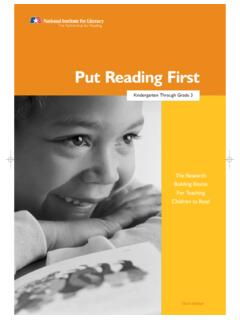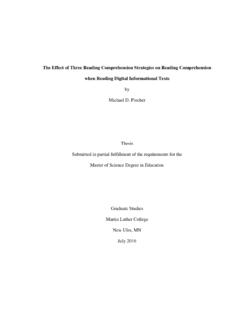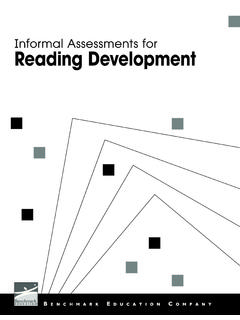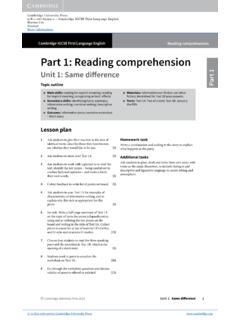Transcription of Improve Reading Comprehension Tto help students learn to ...
1 4/5/2004 11:50 AM Page 82. > SECONDARY READERS Reading SUCCESSFULLY. Carol Porter-O'Donnell Beyond the Yellow Highlighter: Teaching Annotation Skills to Improve Reading Comprehension Annotating a text can be a powerful strategy to comprehend difficult material and encourage active Reading . High school teacher Carol Porter-O'Donnell provides several activities and tools T. to help students learn to purposefully mark up what they read. he hottest-selling item at the univer- active Reading . It makes the reader's dialogue with sity bookstore when I was a college the text (Probst) a visible record of the thoughts student was the yellow highlighter.
2 That emerge while making sense of the Reading . I know because I stocked and sold them while working my way through college. I also Determining Categories for Responding to Text purchased them and made the pages of my books very Before teaching annotating, we ask that students ex- colorful. Annotating, or marking the text to identify amine their written responses to a short story and de- important information and record the reader's ideas, termine the ways readers think about text after was a skill I had observed other learners using but Reading .
3 students read a sentence from their responses never practiced myself because I did not own the and we ask the class, What type of comment is this? books I read in high school. The yellow marks in my What category would that sentence fit into? Once a college textbooks, which left little of the page in its category is named and recorded on newsprint or an original color, did not help me to learn very much. overhead transparency, we have students read addi- Unfortunately, I was nearly a junior in college before tional sentences that would fit into the category.
4 Stu- I knew how to highlight key ideas and write marginal dents can hear what each type of response sounds like notes that helped me make connections, pose ques- and see the variety of ways to react or respond to a text. tions, and interpret ideas. Typically, classes generate six or seven ways of I still did not know how to teach this skill ef- responding. Readers usually make predictions, ask fectively until two years ago, when I worked with two questions, state opinions, analyze author's craft, make teachers one who had the language for teaching an- connections, and reflect on the content or their read- notating and one who was making the process of ing process.
5 Once the list of categories is completed, marking a text visible to his students . Janell Cleland we have students create a cluster or another visual aid and Tom O'Donnell co-taught a Reading class and, that they can use as a reference while writing about by bringing Janell's language and Tom's methodol- their Reading . Depending on the class and the re- ogy together, their students and mine are no longer sponses that emerged, we might continue adding cat- left to learn this process by chance. egories and specifics related to the categories as we examine more responses to text.
6 For example, stu- dents might make connections to similar personal ex- What Is Annotating, and How periences or their actions in similar situations, but Do I Teach students to Do It? they might add connections to other texts (books, Annotating is a writing-to- learn strategy for use short stories, movies, TV shows, lyrics, artwork, and while Reading or rereading. Annotating helps read- so forth) on their visuals to remind them of the var- ers reach a deeper level of engagement and promotes ied ways of making connections.
7 82 English Journal Vol. 93, No. 5 May 2004. Copyright 2004 by the National Council of Teachers of English. All rights reserved. 4/5/2004 11:50 AM Page 83. Carol Porter-O'Donnell Using the Categories to Teach Annotating FIGURE 1. Annotating Text To introduce annotating, we use a short story that can be read aloud in one class period. We make each stu- BEFORE Reading . dent a copy of a story from the class anthology and > Examine the front and back covers (books). > Read the title and any subtitles make an overhead transparency of each page.
8 In addi- > Examine the illustrations tion, we make a transparency of the Annotating Text > Examine the print (bold, italics, etc.). bookmark, shown in Figure 1, with ideas for symbols > Examine the way the text is set up (book, short story, diary, dialogue, article, etc.). to use and marginal comments to make. My colleague Monica Fairman was influential in designing this for- As you examine and read these, write questions, mat to support active Reading . We also help students and make predictions and/or connections near these parts of the text.
9 To distinguish between marks and marginal notes they might use for surface meaning and other marks for DURING Reading . Mark in the text: identifying deep-meaning ideas. For example, students > Characters (who). might create a coding system of circles, squares, and > When (setting). underlining to identify information related to the sur- > Where (setting). face meaning (vocabulary, who, what, when, where, > Vocabulary ~~~~~. > _____ Important information and why) of the text. While annotating for deep mean- ing or underlying messages, students might mark Write in the margins: > Summarize these areas with a symbol such as an asterisk, and mar- > Make predictions ginal notes would be shortened versions of the types > Formulate opinions of responses readers write after Reading .
10 > Make connections > Ask questions While listening to the first page of the short > Analyze the author's craft story, students use the symbols listed on the overhead > Write reflections/reactions/comments to mark information typically found in the opening > Look for patterns/repetitions pages. At the end of the first page, or at a natural pause AFTER Reading . in the text, we stop Reading and give students time to > Reread annotations draw conclusions go back and add marks. Next, we ask them to share > Reread introduction and conclusion try to figure out something new what they have marked, and we make the same mark- > Examine patterns/repetitions determine ings on the transparency of the first page of the story.
